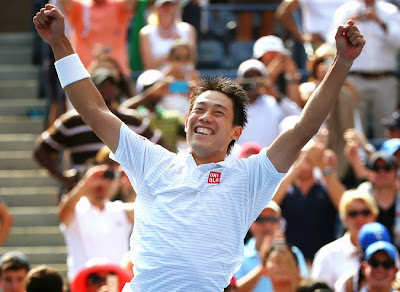As Kei Nishikori has kept fighting through imposing obstacles at this United States Open, a tournament at which he was not even sure to play, his coach Michael Chang has kept reminding him, “You’re not done yet.”
Clearly not. After scrapping his way into the semifinals with consecutive five-set upsets, Nishikori extended his one-man show of resilience by toppling the No. 1 seed, Novak Djokovic, to reach the U.S. Open final.
His 6-4, 1-6, 7-6 (4), 6-3 victory on a muggy Saturday afternoon made him the first man from Asia to reach a Grand Slam singles final.
“It’s, I don’t know, 4 o’clock in the morning,” Nishikori said afterward of the time in his homeland, Japan. “But I hope a lot of people are watching.”
If they were not on Saturday, they will be soon. Nishikori, 24, who left home at 14 to train at the IMG Academy in Bradenton, Fla., has long been a tennis star in his native country, winning an ATP Tour event for the first time in 2008, at age 18, and reaching the fourth round of the U.S. Open that same year.
But his inspiring run in New York should allow him to transcend what remains a minor sport at home.
“This is definitely huge for Japan,” said Djokovic, cast in the odd role of assessing the cultural effects of his own defeat. “He’s been around for the last couple years. He’s been making a lot of success. But playing finals of a Grand Slam and now fighting for a title is definitely something different.”
A title is hardly out of the question given that his opponent in Monday’s final will be another man making his Grand Slam final debut: 14th-seeded Marin Cilic, who is playing and serving brilliantly but who has lost to Nishikori five times in seven matches, including twice this year.
Cilic, 25, and the 10th-seeded Nishikori are part of a new wave in a sport long dominated by Djokovic, Roger Federer and Rafael Nadal. Cilic and Nishikori are the lowest men’s seeds to reach a U.S. Open final since Pete Sampras, who was seeded 17th when he won the title in 2002, in what turned out to be his final professional match.
Nishikori is still getting started. He might have made this sort of breakthrough already if not for a series of injuries, including an elbow problem that required surgery in 2009 and knocked him out of the top 100.
This year, he had to retire from the Madrid final with a back injury after overwhelming Nadal on clay early in the match. He then had a minor operation to remove a cyst on his right foot on Aug. 4. He did not resume practicing at full strength until several days before the U.S. Open began and debated withdrawing.
“Good thing he played,” his co-coach Dante Bottini said.
Relatively small at 5 feet 10, Nishikori can generate surprising power off both wings and is as quick when a point is underway as he is slow when walking to his chair on a changeover or to a gate at Heathrow Airport.
“In the airport, he’s always behind,” Bottini said. “We are always looking for him and going, ‘Where is he?’ He’s so slow that it irritates me sometimes, but if he wants to save the energy for the matches, that’s fine with me.”
Nishikori was born in Matsue, the capital of Shimane Prefecture. Japanese sponsors helped fund his move to Florida, where he soon impressed Nick Bollettieri, the venerable, voluble American coach who once coached Andre Agassi.
“He and Xavier Malisse and Marcelo Rios are the best shotmakers I’ve ever worked with,” Bollettieri said in an interview before this season. “If Kei Nishikori could stay healthy, he could be and would be right up with the big boys.”
Eight months later, there he was at Arthur Ashe Stadium, beating the top-ranked player at something resembling his own suffocating baseline game. Nishikori had played Djokovic twice before, losing in the second round of the French Open in straight sets in 2010 and upsetting him in 2011, near the end of Djokovic’s finest season, in the semifinals of an indoor tournament in Basel, Switzerland.
But this was a grander stage, and his victory was all the more remarkable because he had spent nearly three and a half hours longer on court in this tournament than Djokovic.
Nishikori needed five sets and over four hours to beat Milos Raonic, the fifth seed, in a fourth-round match that ended at 2:26 a.m. Tuesday. He did not get to bed until close to 6 a.m. that morning but bounced back on Wednesday to upset third-seeded Stan Wawrinka, the reigning Australian Open champion, in five sets.
Chang, an American who had an improbable run of marathon victories of his own in 1989 on his way to the French Open title, said that before the match against Wawrinka, he was concerned that Nishikori would still be focusing on the Raonic match.
“So I was, like, constantly telling him, ‘Hey, you’ve got another match here to play, another match, another match,’ ” Chang said, “because that tends to be the struggle with players that have a big win.”
There was no letdown, not against Wawrinka and not against Djokovic, even though he had his opportunities to crack.
He stopped Djokovic’s momentum early in the third set by holding serve in a seven-deuce game and later served for the set at 5-3, only to double-fault on break point. But he shrugged that off and eventually won the tiebreaker, during which Djokovic double-faulted twice. Looking sluggish, Djokovic lost his serve in the opening game of the fourth set and then failed to break Nishikori back after taking a 0-40 lead in the next game.
Like on Facebook
Follow on Twitter
Add on Google+




No comments:
Post a Comment